Twenty-five years ago, planners warned that Tucson's road-building and maintenance budget needed to double to $30 million a year just to prevent the transportation system from worsening. Without additional money, they predicted increased congestion, brown skies and crumbling streets.
Civic leaders recommended a number of projects to relieve traffic congestion, including a series of $2 million "bantam interchanges" around town, an expansion of the reversible lane system, and additional sidewalks and bike paths.
Constructing an urban freeway was not part of the transportation equation in 1976. The community had just undergone a divisive battle over a proposed limited-access highway from I-10 near Ajo Way north to the intersection of Broadway Boulevard and Campbell Avenue. Labeled I-710, the controversial roadway would have cost at least $30 million in federal money, but opposition killed it.
Planners had high hopes for the bus system. Back then, they predicted that by 1996, the percentage of automobile drivers in town would decrease from 84 percent to 70 percent, while bus ridership would rise from 3.5 to 12 percent.
The opposite has happened instead. Bus ridership today accounts for only 2.2 percent of the daily trips taken region-wide, while auto use for the last two decades has consistently accounted for 87 percent of all trips, with the vast majority taken by solo drivers.
Voters also shot down a bantam interchange pilot proposal at Broadway Boulevard and Alvernon Way.
With the removal of cones on Fifth/Sixth Street and the recent end of Broadway's suicide lane, the number of reversible-lane miles has declined over the past 25 years. Instead of building I-710, the city built the considerably cheaper Kino Parkway with considerably less impact on the community.
In 1986, after community leaders failed to increase transportation funding, the Pima Association of Governments released a plan calling for substantially more street construction and an expanded bus fleet. Among the projects recommended for implementation: a six-lane Grant Road; a ring road to be built west of the Tucson Mountains; Sahuarita Road employed as a connecting route between I-19 and I-10; and 17 grade-separated interchanges to be built along 22nd Street, Broadway Boulevard, Kolb Road, and on the northwest side. Local leaders decided on a county-wide half-cent sales tax increase to primarily finance the roadway portion of the plan.
Before the proposition went to the voters in December of 1986, proponents of the tax increase argued that if it failed to pass, the city would one day be forced to bulldoze neighborhoods to make way for freeways. A well-organized opposition dismissed that argument as an empty threat and blasted the plan's heavy reliance on roadways at the expense of mass transit. Passage, they predicted, would just encourage more sprawl. The tax increase was crushed at the polls.
Four years later, sales-tax proponents were back with the BAJA plan. This proposal split funding between mass transit and roadway construction, but again relied on a half-cent hike in the sales tax. A diverse group of opponents argued that this was a regressive means of raising transportation revenue. Once again the voters overwhelmingly rejected the idea.
In 1998 the Pima Association of Governments released a 22-year transportation plan that they said was intended to be financially realistic. But all of the plan's roadway, transit and alternative-mode recommendations meant that three new local taxes would have to be imposed.
Even with the bond revenues and general fund monies already anticipated for transportation projects over the next 22 years, the plan still required significant new revenues. These included an unpopular quarter-cent sales tax increase, which would be devoted strictly to mass transit, and a $2,500 impact fee on all new residential construction in the metro area, which remains politically unpopular within the city. The plan also counts on increased revenues from a higher gas tax, which requires approval from a super-majority of the state legislature. Both the impact fees and gas tax increase would be indexed to inflation, meaning that by the end of the 22-year period they would each have risen substantially.
While in the last three years the towns of Oro Valley, Sahuarita and Marana have joined Pima County in imposing an impact fee, the other two tax increase proposals have gone nowhere. Despite that, PAG has now issued another long-range transportation plan that once again relies on the same unachieved funding sources to implement many of its projects.









